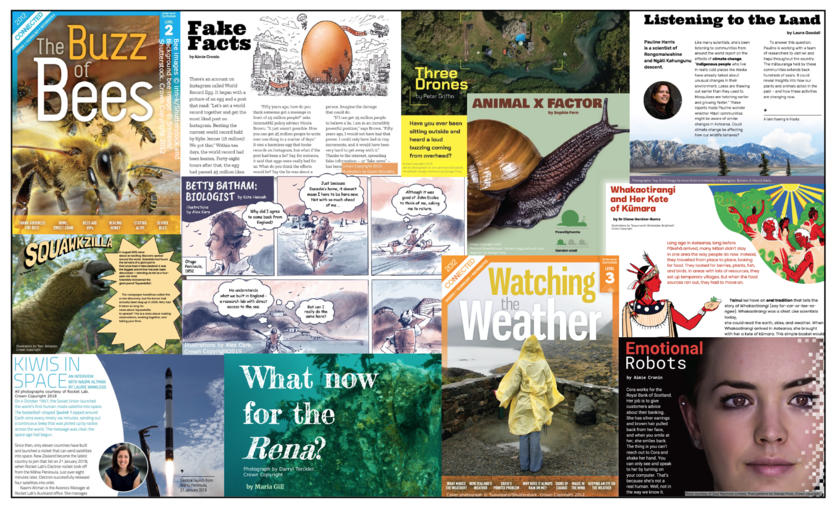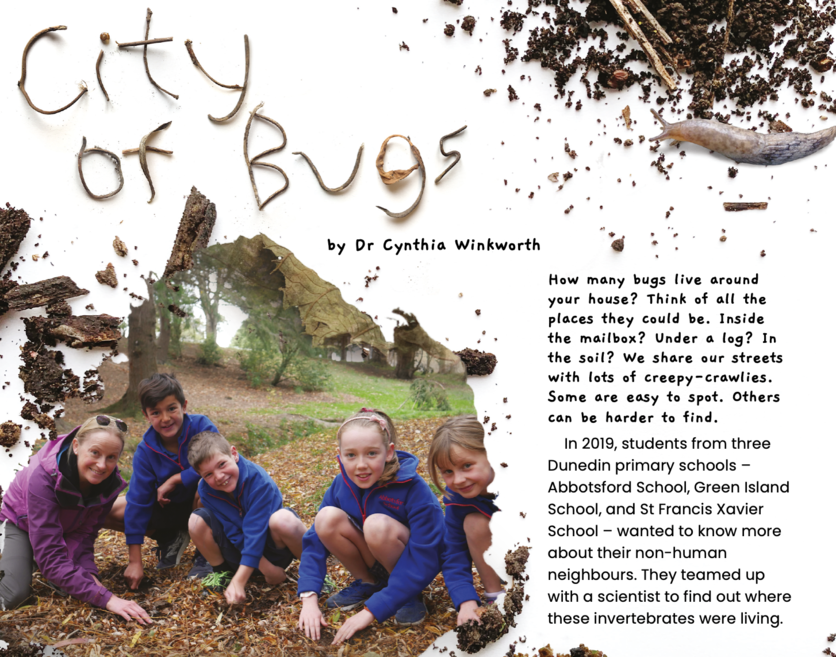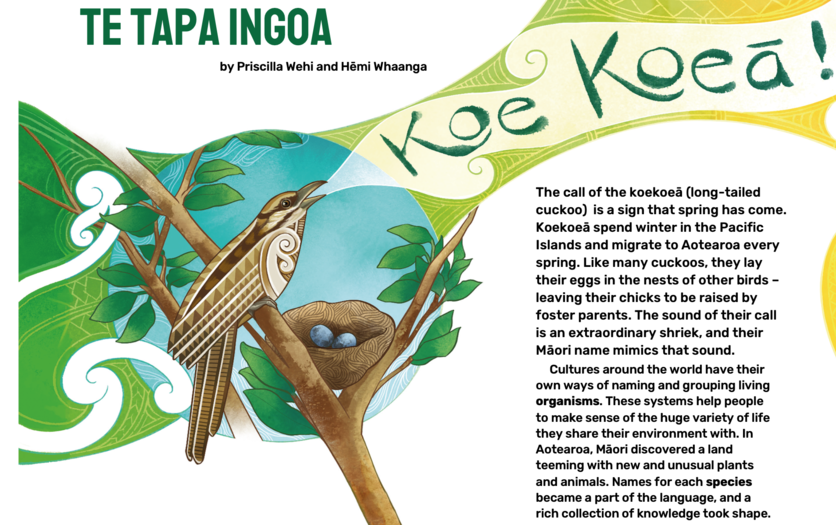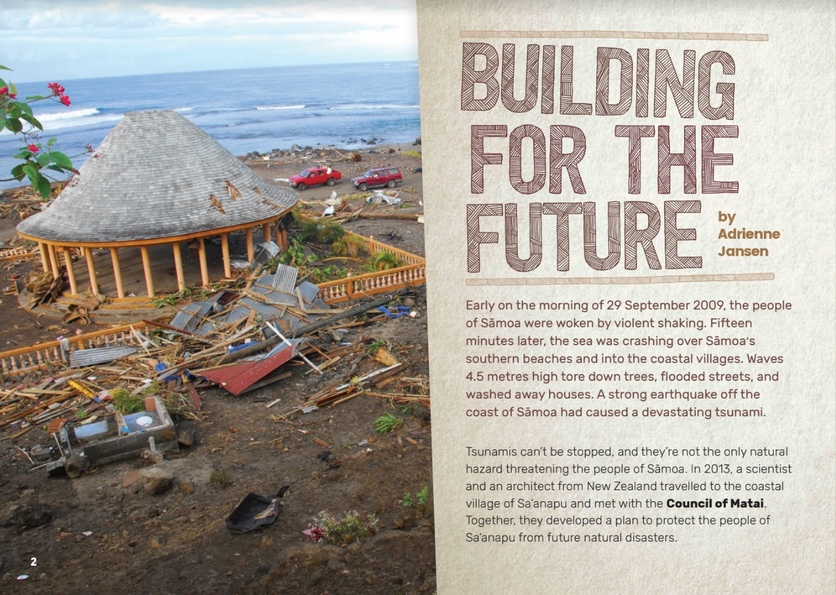The New Zealand Ministry of Education publishes the Connected instructional series to promote scientific, technological and mathematical literacy. Connected is provided to all New Zealand primary schools and since 2013 Connected resources have been freely available to educators and students on Google Drive.
The Hub partnered with Connected to feature selected articles. We share a similar philosophy – engaging students in a critical and informed manner with authentic, contextual STEM resources.
Adding depth with Hub resources
Connected articles are ideal for cross-curricular literacy learning. With thoughtful planning, educators can integrate science with literacy to enhance learning in both areas – the article Literacy through science provides helpful information on how to achieve this.
Hub articles that feature Connected titles serve several purposes. They provide a brief synopsis of the article, associated teacher support material and links to the digital resources on Tāhūrangi. They also provide a wealth of related Hub content and activity ideas – wrap-around resources to deepen or extend student thinking and learning, practise content vocabulary or prompt inquiry.
Sampling Connected articles
This link will take you to all of the Connected articles on the Science Learning Hub.
Alternatively, we have grouped Connected titles by topic and/or concept.
- Adaptation
- Classification
- Ecology
- Environmental monitoring
- Habitat
- Mātauranga and pūtaiao Māori
- Measurement
- Science and society
- Taking action/citizen science
- Technology
Adaptation
The following articles showcase animal adaptations – what helps the animals live in a particular habitat.
- Life in Aotearoa New Zealand
- The buzz of bees
- Catch my drift
- Who’s eating who?
- Can you hear that?
- Raʻui: Giving it back to the gods
- Wildfire
- The fish highway
Classification
The following articles feature how we use classification systems to help us understand living things.
Ecology
The following articles explore the interactions of living organisms with each other and the environment.
- Listening to the land
- Bringing back the birdsong
- Whakaotirangi and her kete of kūmara
- Gardening in the living room
- Counting kākahi
- What now for the Rena?
- Under the sea
- Te tapa ingoa
- Life in Aotearoa New Zealand
- Raʻui: Giving it back to the gods
- The fish highway
Environmental monitoring
Monitoring provides data – information to help us make decisions and take action. The following articles feature monitoring protocols.
- Captured in ice
- Testing the waters
- Three drones
- Kimihia Kermit
- What now for the Rena?
- Sensing data
- Listening to the land
- Under the sea
- Raʻui: Giving it back to the gods
- The fish highway
Habitat
The following articles feature habitats – the natural environments in which organisms live.
- City of bugs
- Counting kākahi
- What now for the Rena?
- Under the sea
- Raʻui: Giving it back to the gods
- Life in Aotearoa New Zealand
- The fish highway
Mātauranga and pūtaiao Māori
Mātauranga and pūtaiao Māori refer to Māori knowledge, Māori ways of knowing and associated practice, and Māori science. The following articles provide rich examples of mātauranga and pūtaiao.
- Whakaotirangi and her kete of kūmara
- Black is back
- Te tapa ingoa
- The science of rongoā
- Counting kākahi
- Kimihia Kermit
- Listening to the land
- Learning from the tangata whenua
- The tsunami that washed time away
- Sun, wind or rain?
Measurement
The following articles feature mathematics in authentic, context-based settings.
- You can count on it
- The takeaway table
- Squawkzilla
- Watching the weather
- More than a box
- Can you hear that?
- The fish highway
Science and society
We commonly encounter science-related issues. The following articles feature how science supports societal issues and how science literacy can help with decision-making.
- Fake facts
- Building for the future
- Black is back
- Emotional robots
- What now for the Rena?
- Betty Batham: biologist
- Animal X factor
- Down the drain
- Keep your cat inside
- Winning ways
- Foulden Maar: fossils or food?
- Wildfire
Taking action/citizen science
The following articles showcase student and/or community action inspired by a local interest or issue.
- City of bugs
- Sea science
- Bringing back the birdsong
- Down the drain
- Kimihia Kermit
- The war on weeds
- Global action
- Defending the dark
- Making scents
- Fostering felines
- Foulden Maar: fossils or food?
- Trees, seas and soil
- The fish highway
Technology
The following articles feature real-life technology-related issues and/or innovations.
- Amazing algorithms
- Beating the wind
- Driving us into the future
- Emotional robots
- Fake facts
- Fostering felines
- The Global Positioning System
- Lighting the sky with Raspberry Pi
- Kiwis in space
- More than a box
- Sensing data
- A sinking feeling
- The long pause
- Three drones
- The war on weeds
- To build a bot
- Turning old into new
- Watching the weather
Nature of science
Communicating in science is a substrand of the nature of science. Connected articles help students to:
- find trustworthy sources of information
- be critical consumers of science
- uncover the purpose and meaning of messages about science
- identify and evaluate the science behind the messages
- use their growing knowledge to identify misrepresentations of science.
Activity ideas
We have created some ‘grab and go’ resources – downloadable worksheet-based resources in Word, which allow educators to edit them to suit students or use them just as they are. They cover literacy, maths and science. The resources are based on the Connected articles, which are available online through Tāhūrangi, and some also have audio files with the stories.
- Birds in my backyard
- Tired muscles
- Frogs for the future?
- Puzzling out Pacific migrations
- Science and partnership with a Sāmoan village
- To be a scientist
Literacy and science PLD
There are multiple connections between science learning and literacy learning. The following webinars identify strategies to deliberately incorporate literacy learning in both areas.
- Science and literacy – making connections
- Fostering literacy through primary science
- Literacy in the secondary science classroom
Our literacy through science topic curates lots of activities, articles and other resources to boost science and literacy. You can filter for primary and secondary resources.
Useful link
The Connected journals can be ordered from the Down the Back of the Chair website. Access to these resources is restricted to Ministry-approved education providers. To find out if you are eligible for a login or if you have forgotten your login details, contact their customer services team on 0800 660 662 or email orders@thechair.education.govt.nz.




